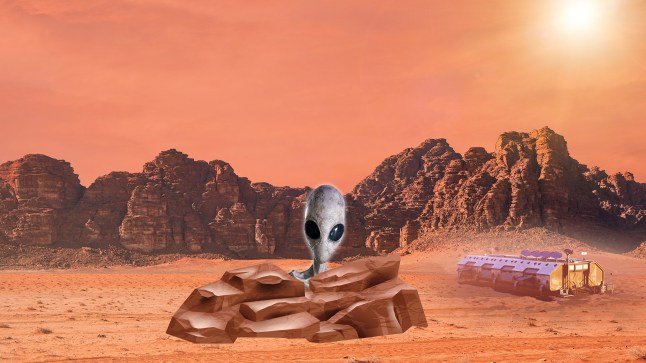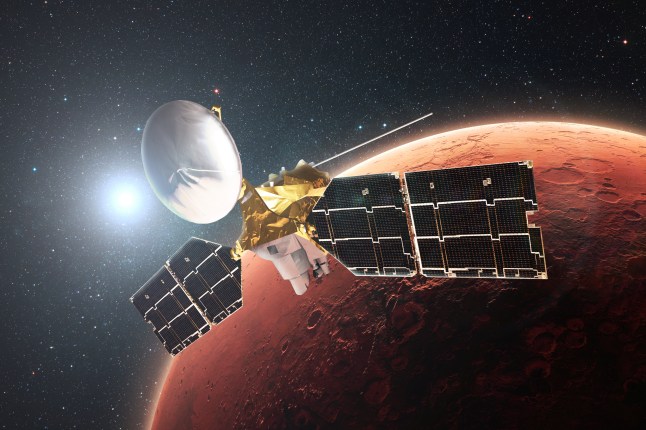 2025-04-19
IDOPRESS
2025-04-19
IDOPRESS

Life might not be on Mars right now – but that doesn’t mean it never has
The answer to whether aliens really do exist could be a lot closer than we think thanks to our celestial neighbour,Mars.
The red planet has been a laser-focus for scientists and truth-seekers alike when they have been searching for evidence of extraterrestrial life.
Now NASA may have helped find it thanks to a signs of a carbon cycle beneath Mars’ dusty surface.
It’s hard to prove that life was once on Mars,so scientists focus on analysing its rocks and molecules as they are the best proof we have at the moment.
During its research,the space agency’s Curiosity rover sniffed out the carbon cycle while driving over its rocky surface.
The cycle sees carbon released,absorbed,released and absorbed on repeat between the atmosphere,ocean,living things,rocks and soils.
It’s the latest study to use Nasa’s Curiosity rover to find out if there is life on Mars,after last month another study found compounds,which are usually made by lifeforms,were found on the planet.

Scientists have struggled to detect signs of life on Mars (Picture: Getty Images)
The paper’s lead author,Ben Tutolo,said these carbon cycles are key to indicating signs of life.
‘It tells us that the planet was habitable and that the models for habitability are correct,’ said Mr Tutolo,an associate professor with the Department of Earth,Energy and Environment in the Faculty of Science at the University of Calgary.
Researchers believe ancient Mars previously had a carbon dioxide-rich atmosphere and liquid water on its surface,which are two key elements beings need to survive.
While rocks are key to discovering this,rovers have never found enough traces of carbon to prove this. So,the University of Chicago scientists analysed data from three sites that the rover had drilled to see if they contained any carbon.

Experts have used the mineral samples dug up by NASA rovers to find evidence,however faint,of life (Picture: Shutterstock / Dima Zel)
The University noted the presence of siderite,‘an iron carbonate material,within sulphate-rich layers of Mount Sharp in Gale Crater’.
The team suspect this mineral formed as water,evaporated and seeped into pores on the Martian surface as the atmosphere dried out,which suggests the planet once had a warm and humid climate.
‘The broader implications are the planet was habitable up until this time,but then,as the CO2 that had been warming the planet started to precipitate as siderite,it likely impacted Mars’ ability to stay warm,’ Tutolo said.
‘The question looking forward is how much of this CO2 from the atmosphere was actually sequestered? Was that potentially a reason we began to lose habitability?’
Discovering siderite,an iron carbonate mineral, took the scientists aback,given that satellites had never picked up on it before on Mars.
‘When we get there on the ground with the drill,we find that it contains more siderite than any deposit that’s ever really been investigated on Mars,’ Tutolo said.

The mineral is a hint that life may have crawled around Mars billions of years ago (Picture: Getty Images/Science Photo Libra)
‘So that’s a surprise,right? And then we have to go back: Did all of those [scientists] that were doing all this very careful work,looking at this data,miss something?’
They didn’t,Tutolo said. Rather,the wily mineral was masked by magnesium sulphate salts,otherwise called Epsom salts.
‘Earth’s surface has been continuously habitable since about 3.5billion years ago,but Mars’ surface evolved from more habitable early on,to uninhabitable today,’ added Edwin Kite,associate professor of geophysical sciences at the University of Chicago and third author on the paper.
‘This discovery helps us understand the mechanisms that drove the two planets down very different paths.’
Does this mean there was once life on Mars? Tutolo’s not sure.
‘Even though these sediments in Gale Crater were laid down about 3.5billion years ago,the planet’s about 4.5billion years old. It didn’t have continually habitable conditions,’ he said.
NASA says its Curiosity rover,which touched Martian ground in 2012,will continue to comb through Mars to help Earthlings understand the planet’s history and how it became the red rock it is today.
It could also help people on Earth with another issue – climate change.
Carbon sequestration – taking carbon out of the air and burying it underground – is something experts like Tutolo have been looking into.
The process happens naturally on Earth,giving the blue marble a balanced atmosphere. Unlike Mars,where its carbon cycle seems to have stored more of the planet-warming gases than released.
As climate change cranks up Earth’s temperature,Tutolo told CBC that Mars may provide humans with a blueprint to ‘inject’ carbon underground.